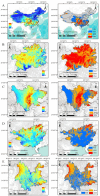Distribution Patterns and Ecological Determinants of Suitable Habitats for the Dhole (Cuon alpinus) in China
- PMID: 40002945
- PMCID: PMC11852048
- DOI: 10.3390/ani15040463
Distribution Patterns and Ecological Determinants of Suitable Habitats for the Dhole (Cuon alpinus) in China
Abstract
As a keystone predator within forest ecosystems, the dhole (Cuon alpinus) plays a pivotal role in shaping the population structure and dynamics of these biomes. In China, dhole populations have experienced a dramatic decline, primarily due to habitat loss and fragmentation, poaching, and other historical factors. However, the distribution patterns of suitable habitats and the key environmental factors influencing their suitability remained unclear. In this study, we employed the MaxEnt model to assess the habitat suitability for dholes across China. The results revealed that the primary factors influencing the distribution of potential suitable habitats for dholes were the mean diurnal range (Bio2), temperature seasonality (Bio4), minimum temperature of the coldest month (Bio6), and elevation. Potentially suitable habitats were predominantly located in the central-western and northwestern regions, with scattered distributions in the southeastern parts of China, while areas of high suitability were mainly concentrated in the central-western region. The proportion of suitable habitats varied significantly among the nine provinces analyzed. This study clarified the distribution patterns of suitable habitats and identified the key environmental constraints affecting dhole distribution in China. The findings provide critical ecological data to support the conservation and management of dholes in the region.
Keywords: MaxEnt model; dhole; environmental factors; potential suitable habitat; wildlife conservation.
Conflict of interest statement
The authors declare no conflicts of interest. The funders had no role in the study’s design, in the collection, analyses, or interpretation of data, in the writing of the manuscript, or in the decision to publish the results.
Figures




Similar articles
-
On a dhole trail: examining ecological and anthropogenic correlates of dhole habitat occupancy in the Western ghats of India.PLoS One. 2014 Jun 3;9(6):e98803. doi: 10.1371/journal.pone.0098803. eCollection 2014. PLoS One. 2014. PMID: 24893166 Free PMC article.
-
Prediction of Potential Habitat Distributions and Climate Change Impacts on the Rare Species Woonyoungia septentrionalis (Magnoliaceae) in China Based on MaxEnt.Plants (Basel). 2024 Dec 30;14(1):86. doi: 10.3390/plants14010086. Plants (Basel). 2024. PMID: 39795346 Free PMC article.
-
Every dog has its prey: Range-wide assessment of links between diet patterns, livestock depredation and human interactions for an endangered carnivore.Sci Total Environ. 2020 Apr 20;714:136798. doi: 10.1016/j.scitotenv.2020.136798. Epub 2020 Jan 18. Sci Total Environ. 2020. PMID: 31986391
-
Methodological approaches for estimating populations of the endangered dhole Cuon alpinus.PeerJ. 2022 Feb 22;10:e12905. doi: 10.7717/peerj.12905. eCollection 2022. PeerJ. 2022. PMID: 35223205 Free PMC article. Review.
-
The current distribution of tick species in Inner Mongolia and inferring potential suitability areas for dominant tick species based on the MaxEnt model.Parasit Vectors. 2023 Aug 16;16(1):286. doi: 10.1186/s13071-023-05870-6. Parasit Vectors. 2023. PMID: 37587525 Free PMC article. Review.
References
-
- Wei F.W., Feng Z.X., Wang Z.W. Overview of the study of habitat selection by wild animals. Chin. J. Zool. 1998;33:48–52. (In Chinese)
-
- Shangguan Z.Y., Feng C.F., Wang J.N., Wan D.M., Zhang L. Habitat suitability analysis of Asian badgers (Meles leucurus) in the western Liaoning Province based on MaxEnt model. Acta Theriol. Sin. 2024;44:611–621. (In Chinese)
-
- Zhu G.P., Liu G.Q., Bu W.J., Gao Y.B. Ecological niche modeling and its applications in biodiversity conservation. Biodivers. Sci. 2013;21:90
-
- Peterson A.T. Predicting species’ geographic distributions based on ecological niche modeling. Condor. 2001;103:599–605.
-
- D’Elia J., Haig S.M., Johnson M., Marcot B.G., Young R. Activity-specific ecological niche models for planning reintroductions of California condors (Gymnogyps californianus) Biol. Conserv. 2015;184:90–99. doi: 10.1016/j.biocon.2015.01.002. - DOI
Grants and funding
LinkOut - more resources
Full Text Sources
Research Materials

